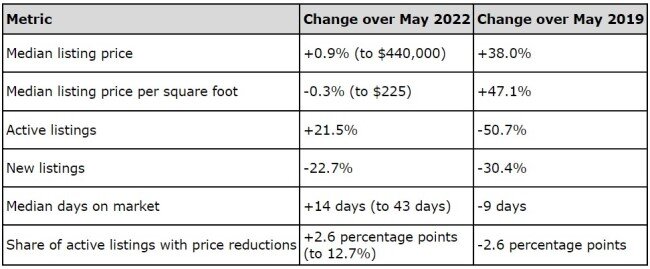Residential Real Estate News

America's Home Prices May Not See a New Peak in 2023
Residential News » Los Angeles Edition | By David Barley | June 1, 2023 8:47 AM ET
Home Price Gains Slow to Lowest Rate on Record in May
Based on Realtor.com's latest Monthly Housing Trends Report released today, U.S. home prices rose slightly in May 2023, but price growth slowed to the lowest rate on record since 2016, suggesting home prices may not see a new peak in 2023.
Additionally, home inventory growth continues to slow and is declining in many metro areas across the country as fewer sellers list their homes than last year and buyers compete over the remaining affordable homes for sale.
"April and May are historically popular months to buy, and typically by this time in the year we've exceeded the prior year's peak home price. Weakening home price growth for the past 12 months is increasing the odds that we may not see a new home price peak this year, for the first time in the history of our listing data, which dates back to mid-2016, and this is likely welcome news to home shoppers," said Danielle Hale, Chief Economist for Realtor.com. "Despite stalling price growth, home listing prices are up slightly compared to last May, and with rates more than a percentage point higher than a year ago, buyers continue to face affordability headwinds. The good news for sellers is that buyers are still out there, and this month's slower growth in the active inventory of homes for sale indicates that shoppers are in the market and actively searching for homes that fit their needs and budget."
What it means for homebuyers, sellers, and the housing market
A slower housing market means buyers in certain areas may find they can once again have an offer accepted when putting less down. A recent report from Realtor.com found down payments declined for the first time since the second quarter of 2020, suggesting it's getting harder for buyers to keep up with costs and that a less competitive housing market may be opening up opportunities for buyers making somewhat smaller down payments.
"As buyers' budgets are being stretched to the max, there are opportunities for negotiation, especially on homes that have been sitting on the market for a while," said Realtor.com Executive News Editor Clare Trapasso. "They can ask sellers to come down on the price, make costly repairs, as well as contribute to their closing costs or buy down their mortgage rates. If they're purchasing new construction, they can also request upgrades. This can add up to substantial savings."
May 2023 Housing Metrics - National Data

Home price growth stalls
Home listing prices were slightly higher in May compared to a year ago, but growth in the typical asking price of for-sale homes continued to decline to the low single digits. In addition, the median listing price on a square foot basis declined compared to last year for the first time in Realtor.com® data history. At this rate of slowing, asking prices are likely to decline relative to the previous year by next month. Despite this trend, home sellers continue to have high expectations of the housing market and buyers, in some cases, too high. The number of homes with price reductions - a sign that a seller needed to adjust pricing to attract a buyer - was higher than year ago levels but in line with pre-pandemic years.
- The U.S. median list price grew to $441,000 in May, up from $430,000 in April, and down -1.7% from June 2022's record high of $449,000. The annual growth rate slowed to +0.9% in May, down from April's 2.5% growth rate, to the lowest price growth in our records since 2016.
- Nationally, the median listing price per square foot declined (-0.3%) compared to the previous year for the first time in our data history since 2016.
- Higher mortgage rates and home prices compared to May of last year increased the monthly cost of financing 80% of the typical home by roughly $296 (+15.5%) compared to a year ago.
- Among the 50 largest U.S. metros, 15 out of the largest 50 markets saw their median list price decline. The greatest price declines were seen in Texas metros: Austin (-7.3% year over year), Houston (-5.9%), and San Antonio (-5.8%).
- Nationally, 12.7% of active listings had their price reduced in May, up from 10.2% in May of last year. While higher than last year, the rate is below typical 2017-2019 levels. Large southern metros saw the largest increase in the percentage of homes with price reductions, led by Austin, Texas (+11.9 percentage points year over year), San Antonio, Texas (+9.1 percentage points) and Oklahoma City, Okla. (+8.7 percentage points).
Inventory tightens as fewer sellers list and buyers compete over remaining homes
The U.S. supply of active homes for sales continued to grow in May relative to this time last year, but slowed for the third month in a row as fewer potential sellers opted to list their home for sale and as the market lapped the period of higher inventory growth that started in May 2022. Today's buyers are grappling with low inventory, but the slowing growth in active inventory in May indicates that buyers continue to search for and find deals. Despite sitting on relatively high home equity, sellers are staying on the sidelines, and the number of newly listed homes remains well below last year's level. In fact, the pace of new home listings in May was even lower than in May 2020 when the real estate market was still contending with pandemic-era closures and restrictions.
- Nationally, the number of active listings grew +21.5% year over year in May; however, the inventory growth rate continued to slow for the third month in a row. Both newly listed homes (-22.7%) and homes under contract (-18.1%), or pending listings, declined year over year.
- Compared to last year, active inventory decreased in 21 out of 50 of the largest metros. Markets that reported large yearly declines included San Jose, Calif. (-35.3%), Sacramento, Calif. (-27.3%), and Hartford, Conn. (-26.0%).
- Among the 50 largest metros, active inventory increased 20.8% over last year, driven exclusively by Southern metros, such as Nashville, Tenn. (+124.7%); Austin, Texas (+112.5%), and San Antonio, Texas (+93.4%). Despite high inventory growth compared to last year, most Southern metros still had lower inventory levels compared to pre-pandemic years.
- On average across the 50 largest metros, no region or metro area saw year-over-year increases in new listings in May. The South saw new listing activity decline the least (-20.4%) compared to the previous year, while they fell 32.9% in the West, 22.9% in the Northeast, and 22.8% in the Midwest.
More days on market gives buyers time to search for homes and bargain
In May 2023, the typical home spent two weeks longer on the market than the same time last year, but a shrinking difference since January's recent high suggests buyers are out shopping for homes and competition still exists. That's keeping sellers in a very good position, with well-priced, updated homes still attracting buyers and selling more than a week faster than was common before the pandemic.
- In May, the typical home spent 43 days on market, 14 days longer than this time last year, but 9 days faster than the pre-pandemic May 2017-2019 average.
- Across the 50 largest U.S. metros, the typical home spent 37 days on the market, 13 days more than the previous May. This trend was seen across all regions, with larger metros in the South seeing the greatest increase (+16 days), followed by the West (+12 days), Midwest (+9 days) and Northeast (+7 days).
- All of the 50 largest metros saw an increase in time on market compared to the previous year. Time on market increased the most in Raleigh (+31 days), Austin (+28 days), and Miami (+27 days).
Sign Up Free | The WPJ Weekly Newsletter
Relevant real estate news.
Actionable market intelligence.
Right to your inbox every week.
Real Estate Listings Showcase
Related News Stories
Residential Real Estate Headlines
- Las Vegas Area Home Prices Uptick 4.3 Percent Annually in March
- Single-Family Rent Growth in U.S. Trends Upward in 2025
- U.S. Mortgage Rates Tick Down Post Trump Tariffs Commencement
- President Trump's 'Liberation Day' Tariffs Potential Impact on the U.S. Housing and Mortgage Markets
- Baby Boomers Biggest Cohort of U.S. Home Buyers in 2025 as Millennials Decline
- U.S. Monthly Housing Payments Hit Record High in 2025
- U.S. Pending Home Sales Uptick in February
- Global Prime Residential Rent Slowdown Continued in Late 2024
- Ireland Home Price Inflation Hits 8 Year High in Early 2025
- Existing Home Sales in America Uptick in February
- Great Miami Area Residential Sales Decline 15 Percent Annually in February
- Mortgage Rates Uptick in Mid-March, Ending 9-Week Decline in U.S.
- World Property Ventures Builds the Future of Real Estate with New Funding Round
- U.S. Builder Sentiment Declines Amid Economic Uncertainty and Rising Costs
- Black Homeownership Rates in U.S. Enjoy Largest Annual Increase of All Racial Groups
- Wealthy Renters Are Taking Over More of the U.S. Rental Market
- If U.S. Congress Does Not Extend NFIP Soon, Thousands of Daily Home Closings Impacted
- U.S. Mortgage Applications Spike 11 Percent in Early March
- Greater Palm Beach Area Residential Sales Rise in Early 2025
- New Apartments in U.S. Are Leasing at Slowest Pace on Record
- U.S. Mortgage Rates Drop to 4 Month Low in March
- Overall U.S. Mortgage Delinquency Rates Dip in December
- New Tariffs on Canada, Mexico to Impact U.S. Homebuilder Input Costs
- Monaco's Property Market: A Tale of Two Cities
- U.S. Home Purchase Cancellations Surge, 1 in 7 Sales Getting Canceled
- U.S. Pending Home Sales Hit Historic Low in Early 2025
- Greater Miami Area Residential Sales Dip in January
- Governor DeSantis Supports Ending Property Taxes in Florida
- WPV Aims to Become the Berkshire Hathaway of Real Estate Tech
- U.S. Home Sales Slump Continues in January
- Average Americans Spend 38 Percent of Monthly Income on Mortgage Payments
- Switzerland's Safe-Haven Appeal Grows with World's Wealthy Homebuyers
- U.S. Builder Confidence Rapidly Declines in February
- Las Vegas Home Sales Rise 6.7 Percent Annually in January, Condo Sales Dip
- Homebuyer Demand in America Drops to 5-Year Low in Early 2025
- Ownership More Affordable Than Renting in Most U.S. Markets
- The World's First Global Listings Service Launches, Called a GLS
- Home Prices Continue to Rise in 89 Percent of U.S. Metros in Late 2024
- Global Luxury Residential Prices Showed Gradual Improvement in Late 2024
- U.S. Construction Hiring Rate Drops to Lowest Levels in 5 Years





